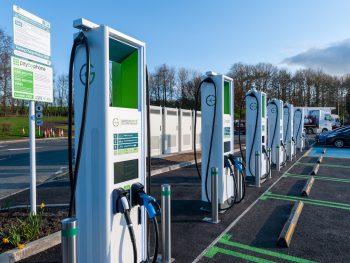Motorway electric vehicle charger target missed, finds RAC
The Government has fallen “well short” of a vital target for high-speed motorway electric vehicle chargers, new research by the RAC reveals.

The Moto-run services at Exeter on the M5 has the most high-powered chargers of all motorway services, with 24 devices
The goal by Ministers was for every motorway service area in England to have six or more rapid or ultra-rapid electric vehicle chargers by the end of 2023.
But just 46 (39%) of 119 motorway services reviewed by the RAC on Zapmap meet the target. That’s up from the number of 27 (a 23% rise) at the end of April 2023 but far short of the year-end goal.
And four motorway service sites – Leicester Forest on both sides of the M1, Tebay South on the M6 and Barton Park on the A1(M) – still have no charging facilities whatsoever, while 18 service areas have no rapid charging above 50kW.
The Government’s goal for motorway services to have at least six rapid chargers above 50kW by the end of 2023 was revealed in its EV infrastructure strategy published in March 2022 – and included a target for some to have more than 12. These plans were intended to be supported by the £950m Rapid Charging Fund (RCF). However, the fund has still not opened nearly two years on, although a £70m pilot went live late last 2023. A consultation on how best to design the RCF is now live – and closes 14 February 2024.
RAC EV spokesperson Simon Williams said: “It’s clear from our research that the Government has fallen well short of its target of having six high-powered chargers at every motorway service area in England.
“There is undoubtedly an eagerness among charge point companies and motorway service operators to install these types of units but unfortunately, it’s often the high-power cabling to the grid that’s the major barrier which is out of their hands.
“More clearly needs to be done to make this process simpler than it is currently. Hopefully once the Government’s Rapid Charging Fund kicks fully into action some of these hurdles will be overcome.
“We continue to believe that the wide availability of ultra-rapid charging is crucial in giving both current and future EV drivers confidence to know they can easily make journeys beyond the range of their vehicles in a time-efficient way.”
Latest Zapmap figures show access to high-speed charging at motorway services is crucial to tackling range anxiety and helping drivers shift to EVs. Its research found motorway services and EV charging hubs have displaced supermarket car parks as the most popular charging locations in the UK.
More than half (55%) of respondents in its annual EV charging survey indicated they regularly stop at motorway services to charge, up from 48% in 2022.
While motorway service operators are working to roll out high-speed charging, the issue of securing grid connections remains ongoing.
In the 2023 Autumn Statement, the Government pledged to support grid reforms to cut connection waiting times.
Dominic Rowles, head of automotive at NTT DATA UK&I, said that the missed motorway charger target shouldn’t be a massive surprise and said that once the grid access barrier is removed, a wave of new market entrants will enter the EV infrastructure market.
He commented: “The Government’s target was overambitious from the outset, established long before a solid plan was in place to build the required number of rapid charging points. We should see this missed target as more of a bump in the road than a failure, particularly with 2023’s Autumn statement in mind. In fact, the root cause of the missed target has been a lack of access to the grid.
“Once the access issue goes away, we will see new businesses investing in and entering the EV infrastructure market with creative approaches at a rapid pace. My expectation is that the new market entrants will emulate other digital disruptor technologies – focusing on a really smooth user experience and potentially a buy-and-sell marketplace. We could have an Airbnb model for car charging very soon, but the innovators will not only have to focus on user experience but also use data and AI to accurately locate the areas that most need rapid charging points and create a plan of action for installation. Ultimately, we will need smart data-driven decisions, rather than rash ambition, to make the transition to electric a success.”
Elsewhere, the RAC analysis of Zapmap data reveals that since the end of spring 2023, a further 178 high-powered chargers have been installed at motorway services. There are now more than 400 ultra-rapid chargers at services, which means more than half (55%) can now offer some of the fastest possible charging speeds to drivers.
At the 101 services offering high-powered charging, there are now 693 Combined Charging System (CCS) connectors – the most common charging connector; an increase of 225, or 48%. For the CHAdeMO connectors predominantly used by Nissan and Renault electric cars, there are now almost 300 (282), up 32% compared to the end of April.
There are now 14 services in England which have more than 12 such devices – up from only six in the spring. The Moto-run services at Exeter on the M5 has the most high-powered chargers of all motorway services, with 24 devices. Looking at all high-powered motorway chargers collectively, there are currently an average of five (4.9) devices at all 119 service areas in England – up from 3.4 at the end of April.












